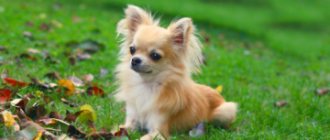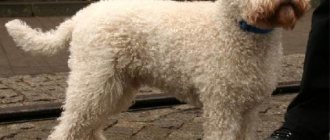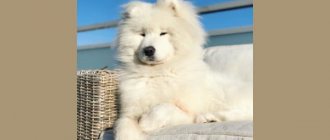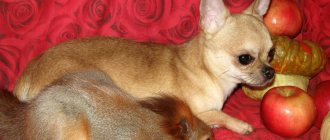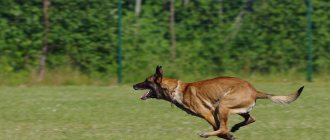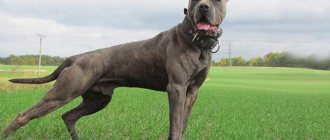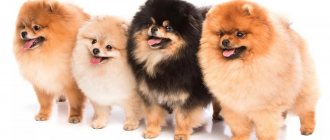Brief history of the breed
Spitz-shaped animals existed long before our era. Information about them appears in historical sources found in Egypt, on the territory of Ancient Rome. In the West, Spitz is the name given to all square-shaped dogs with an elongated muzzle and full of fluffy hair. It is believed that they have a single ancestor - the northern wolf or wolfdog.
The Dwarf Spitz or Pomeranian is a breed developed in the 18th century in the German region of Pomerania, following the introduction of the German Spitz. The dogs were different because the selections were not carried out in a consistent manner. But after 1870, when the British aristocracy noticed the dogs, the dwarf Spitz received its own kennel, and later a club and a standard of appearance.
Interesting! The first Pomeranians weighed up to 13-14 kg and were considered large. But after moving to the UK, the mini dogs were subjected to work by breeders aimed at reducing the size of the breed.
Application
The ancestors of the Pomeranians, like the Schipperke , were good at working as watchmen and shepherds.
However, selection completely eliminated the practical side of using the breed.
Today, these Spitz dogs, along with Boston Terriers and Miniature Pinschers, can be good company for active people and cheerful friends for teenage children.
Long-haired Spitz and his brother with a fashionable haircut
Interesting facts about Pomeranians
- Dwarf Spitz is a Pomeranian breed, the popularity of which was given by Great Britain. Queen Victoria was known to be a lover of these cute mini dogs, she kept a whole shelter and collected figurines.
- Super mini Spitz or dwarf - a descendant of northern sled dogs with the character of a real wolf. In the European group they are the smallest, but they are combative and fearless.
- Despite the prohibitions of the standard, dogs are cut. The groomer will choose a comfortable, stylish haircut so that the baby does not feel hot. This makes maintenance easier.
- Mini Pomeranians are often confused with German ones. Some cynological organizations consider these breeds to be one. But officially, the Pomeranian is described by separate standards, which is due to differences in appearance.
- Recently, bear-type Pomeranians with a short muzzle, round head and snub nose have become popular. Such individuals are considered incorrect from the point of view of the standard and cynology. Officially, Pomeranians have no subspecies.
Standards and appearance
The Dwarf Pomeranian Spitz is almost a pocket dog in size, because the average weight of the breed ranges between 3-5 kilograms. The height of the animals is 18-22 cm, the volume is added by fluffy long hair (the main feature). The smallest among its brothers, even the small Spitz (Klein) surpassed the Pomeranian in terms of height characteristics (23-29 cm at the withers, weighs more than 6 kg).
The latest breed standard was published in 1998. The characteristics have remained almost unchanged, but the rules for culling puppies have become stricter.
- The head is wedge-shaped with a wide skull between the ears. Stop is expressed. Round forehead, bright occipital protuberance.
- The muzzle is narrow, fox-like. The ratio to the length of the skull is 2:4. Scissor bite, full set of teeth.
- The nose is small and round.
- The ears stand firmly on cartilage, set high and close. Small, triangular, but hair growth makes them round.
- The eyes are medium in size, set close, slightly slanted. Rounded, but tending towards an oval. The iris is always dark.
- The body is strong and square in appearance. The topline is descending. The back is short, the withers are not pronounced, the croup is straight. The chest is well lowered, the stomach is tucked. The neck is thick, short, perpendicular to the body.
- The tail is of medium length, set high, carried over the back.
- Limbs are straight and dry. Paws are rounded. The description of the breed gives characteristics of movements: light, springy.
- The coat is two-layered: long guard hair and short undercoat.
Wool quality
Primitive northern dogs gave the Spitz a practical and unpretentious coat. The outer hair is called guard hair; it protects the Pomeranian from moisture, dirt, sunlight and physical damage. The outer coat is straight, shiny, and hard.
The undercoat is the fine, soft hair that lies beneath the coarse outer hair. Thick and dense, it protects the dog from overheating in summer and hypothermia in winter.
The Pomeranian Spitz has distinctive features of its appearance:
- Elongated, lush coat - a “collar” around the head;
- A fluffy “hat” on the head;
- Long hair on cheekbones;
- Itching on the back of the limbs;
- Long hair covering the tail;
Incorrect structure:
- Curly, wavy coat;
- Soft guard hair;
Breed varieties
A single standard has been developed for the breed, adopted by the FCI. Officially, there are no varieties of Pomeranian. In the same breed group and section along with the dwarf are the German, Kleine, Grossspitz, and Wolfspitz. All animals have different colors, heights and personalities.
In some countries, the standard Pomeranian is combined with the German or standard Spitz. The United States is trying to develop its own type of breed, called the bear breed. The American Dwarf Mini Spitz has a short upturned muzzle, large close-set eyes, and a rounded skull.
Such deformations may in the future lead to the development of genetic hereditary diseases associated with breathing and the visual apparatus. The bear type is already accepted for exhibitions, but European breeders reject such puppies.
Color and coat type
Wool is a real calling card. This type is typical for all Spitz dogs: smooth, hard guard hair (up to 7 cm) and a soft, thick, padded undercoat. In cold climates it hardly falls. The shortest pile is on the ears and muzzle and forehead. A collar forms on the neck, and a fountain forms on the tail.
Among the colors, black, red and white Spitz are common. Also found in apricot, gray, tan, cream, brown. The head is often darker than the collar and body.
White Spitz - character description
The character of the dwarf Spitz can be called “eternal holiday”. It seems as if these kids never get tired or lose heart. They are constantly on the move: running, barking, playing. They need to walk a lot and communicate, otherwise consequences cannot be avoided: torn shoes, scratched furniture, broken dishes. Mini Spitz will find their own entertainment.
Pomeranians are very inquisitive. They love to watch people and animals and often sit on the window. The breed is peaceful, non-conflict, and gets along well with other pets. But the small Pomeranian does not like children's pranks, so a small child should not have such a pet.
The breed is characterized by a sharp, inquisitive mind. Mini Pomeranians learn quickly, easily remember commands and are happy to carry them out in exchange for treats. But due to their high intelligence, mini Pomeranians often consider themselves the most important in the family, they are stubborn and try to manipulate.
Photos of the main colors
Pomeranians can come in a variety of colors.
In accordance with the classification of the American Kennel Club, they are divided into 3 large groups:
- black, brown and zone gray;
- red, cream, sable;
- other colors.
IMPORTANT!
The final color of the Pomeranian's coat is formed after the first molt and may differ from what it was at birth.
Ginger
The most common color. Any intensity of red shade is acceptable, as well as lighter hair on the “pants”, muzzle, ears and tip of the tail.
The presence of brown color is unacceptable; the predominance of white hairs is considered defective.
In puppies, the guard hair may be light orange and the undercoat gray.
Cream or beige
The standard does not list acceptable shades, so dogs with cream coat of any intensity and shade are allowed to participate in the exhibition.
In general, cream color is divided into rich (warm) and cold, which visually looks white, but has a beige tint.
The coat of such puppies at birth can be white, beige, or even white with splashes of yellow.
Black
The coat is a solid glossy black color. It is noteworthy that in such dogs the skin, lips, nose and undercoat should also be black.
Puppies' fur may be brown or dark gray.
If a puppy born from completely black parents has small light hairs on the undercoat, this is not considered a serious defect and a violation of the standard. The disadvantage is also early gray hair in the muzzle area and slight fading of the undercoat.
Large spots of white or some other color are considered a significant defect.
To ensure that the color of the dog’s coat does not change after molting, it is necessary to ensure that there are no dogs of a different color in the family tree.
White
Pomeranians with a completely white coat are not albino, but leucistic - their nose, lips, eyes and skin are colored.
White is the main color of oranges, but it is not easy to achieve.
Most often, the coat is not snow-white, but has a creamy tint. Absolutely white dogs can only be born from the same parents. It is also important that their ancestors in the family tree are also white, otherwise later generations may develop some coloration.
According to the standard, any, even the slightest colored inclusions or spots of yellow color are considered defective.
Sable
This color belongs to the zonal color and consists of 2 colors: the undercoat is an iridescent light tone, and the guard hairs at the tips can be of different shades - from red and creamy sand to rich dark gray. It is important that the color of the muzzle and ears be identical.
Color can be of 3 varieties:
- red sable;
- creamy sable;
- gray sable.
Blue
Blue is a rare and expensive color.
The coat of blue Spitz dogs is evenly colored gray of varying intensity with a smoky tint.
Zone gray
This color is also called wolf color. It is quite rare in Pomeranians and is prized by breeders.
With this color, the coat has a grayish color with a silver tint, the eyes are clearly outlined, the ears are colored dark, and the muzzle is a rich grayish tint, the tail is black at the tip, the undercoat is whitish, the hair on the forearms and feathers is light.
Puppies are born almost black, but with age they lighten and the undercoat becomes thicker.
Brown or chocolate
Brown (chocolate) oranges do not have the pigment that makes their coat black, so its color matches the color of the nose, lips and eyelids. Of particular value are dogs that have a rich chocolate color.
After shedding, dogs' coat color does not change, but as they mature, light hairs may appear on the undercoat.
White Spitz - care and maintenance
Caring for a Pomeranian is not difficult. Despite the long hair, the breed is unpretentious and only needs regular combing, grooming and bathing. The main thing is to monitor the moral and physical condition of the mini pet, conduct timely examinations at the veterinary clinic, and get vaccinations.
The breed is only suitable for indoor use. Although long hair will protect the dog from the cold, in a street kennel the Mini Pomeranian will feel lonely. In the apartment you need to install a sun lounger, bowls on stands, it is better to purchase toys and combs in advance.
Important! Caring for a puppy is more difficult, but if you buy a pet at 2-3 months, it will be easier to train it. Adult dwarf Spitz dogs require less attention, but are also more difficult to train.
White Spitz - the right diet
The Pomeranian is not a mini bear, it is not omnivorous. Feeding from the table (dinner leftovers, bones, missing food) is prohibited. A pet should not know what sweet, fatty, fried, smoked and salty foods are. Pomeranians cannot eat flour products, potatoes, pork, butter, or chocolate. Babies quickly gain weight, and with an increased diet and insufficient activity, obesity appears.
The owner can feed the Pomeranian mini bear cub with natural or dry food. Super-premium industrial food contains all the necessary minerals and vitamins, protein and carbohydrates. It is better to choose food for small breeds with average activity. It is better to take a closer look at hypoallergenic products (grain-free, holistic, human grade).
The dwarf Spitz is unpretentious and eats natural food well. The owner can independently buy food and create the pet’s menu. A serving should consist of 40-50% protein, 30-40% carbohydrates and 10-20% fat. They use chicken, beef, rabbit and turkey, sea fish, cottage cheese, kefir, buckwheat, oatmeal and rice.
Adult Pomeranians eat 60-100 grams of food twice a day. The bowl is removed after each feeding. The drinking bowl should always be filled with clean water.
Character
Spitz are very nimble and energetic dogs. It is difficult for them to sit still when there is so much interesting things in the world! The dog's attention will be attracted by a guest, a ringing phone, the owner's call, and absolutely any little thing.
Calmness is completely out of character for her. Some representatives of the breed strive to perform security functions. But this is rare. Males are more likely to bark at unfamiliar guests than females.
Sociability is another character trait characteristic of the Pomeranian. He will begin to communicate with great joy with a person, an animal, and even an inanimate object. A lot of things attract his attention: from loud human laughter to the rustling of grass on the street.
A joyful and active dog will happily frolic, run and briskly chase after the owner who is playing catch-up with him. By the way, it is rare to find fat Spitz dogs. The dog's mobility and energy allow it to maintain a good metabolism in the body. Therefore, she rarely gains weight.
Excessive curiosity and agility make the Spitz greet every living creature that comes his way.
These dogs tolerate loneliness relatively easily. Yes, they are upset when the owner leaves for a long time. But during the period of separation, they will probably find something to occupy themselves with. Such an animal can easily be left with friends or relatives if you are going to leave for a long time. It tends to be trusting and obedient.
You should not think that the Pomeranian will be offended and begin to play dirty tricks on your friends with whom you leave him. No, a smart dog will understand that you will soon take him away and will try not to be sad at the time of separation.
He will begin to listen to strangers who will soon become “friends” for him. An adult is an authority figure for such a dog. But she treats children with less respect.
In a pack of dogs, the Spitz will strive to prove itself as a leader. It is important for him to earn the respect of other four-legged animals, no matter that some of them are significantly larger than him. But, even being an authority for others, such a dog will not behave immorally. That is, he will not humiliate or in any way offend other animals.
Important ! This dog can't stand cats. Making them friends is almost impossible. At the sight of a cat, the Pomeranian Spitz goes into a rage.
The psychological state of such a pet depends on the emotional climate in the family. If household members treat him kindly, the dog will be cheerful and gentle, and if he is rude, he will be irritable. Such an animal needs careful and tolerant treatment.
It is sensitive and very vulnerable. Any rudeness said to a decorative dog deeply hurts it. Therefore, in order for your four-legged pet to always remain happy, do not stop showing him your reverent feelings.
Training and education
The dwarf Spitz is a mini spring, a perpetual motion machine, a naughty boy and a prankster. These dogs are constantly on the move, they need to walk, run and socialize a lot. But even such a small decorative dog needs training; without education, the Spitz will not obey, and its natural habits often drive you crazy.
To control your pet, you need to train it from the first minutes of acquaintance. The child must understand that the owner’s word is the law; in the house, as well as outside it, the person is in charge.
It is necessary to clearly delineate the boundaries of what is permitted: you cannot sleep on the owners’ bed; It is prohibited to play with clothes, shoes and furniture; taboo on loud barking, begging.
To communicate with a pet, the owner must teach it basic commands and words: “sit”, “near”, “lie down”, “voice”, “no”, “food”, “walk”, “carry”. The dog must also remember its name. Training should be structured as a set of games, using treats and toys. You cannot scold, beat or insult a Spitz.
White Spitz - hygiene
It is believed that Pomeranians hardly shed, so they do not cause problems in care. But in a warm climate, infrequent walks and a middle-class diet, the small Spitz sheds its hair regularly. To prevent tangles from forming, your pet should be combed daily with a long-tooth comb or slicker brush.
Animals are not bathed often, once a month or when dirty. The white dwarf Spitz needs regular water treatments. After the “bath”, be sure to dry it with a hairdryer or dry it thoroughly with a towel. Be sure to wash your paws after every walk.
While bathing, you need to brush your teeth with baby or dog toothpaste and clean your eyes of discharge. It is better not to wet your ears to avoid otitis media. Dogs' nails are trimmed 1-2 times a month.
Important! If the mini Spitz does not participate in exhibitions, then it can be cut every 2-3 months, especially in the summer. Also, long hair requires regular treatment against ectoparasites. Anthelmintic medications are given once every 3 months for prevention.
Vaccinations and susceptibility to disease
The Miniature Spitz is a healthy, active dog that remains active even in old age. The breed has almost no genetic diseases, but without proper care, problems with the coat and the musculoskeletal system appear.
Diseases that Pomeranian owners face:
- Allergies and obesity;
- Joint dysplasia, patella dislocation, fractures;
- Conjunctivitis;
- Cataract;
- Weak teeth, tartar, crooked incisors, delayed replacement of primary canines.
Disqualifying faults
A serious violation leading to disqualification from any show is the presence of white spots on the coat of any color other than white. Sometimes white spots may appear on the tips of the paws and on the chest. However, this will not be a reason for disqualification.
Another violation would be a non-black nose on any Pomeranian other than a brown one. In the latter, the nose usually matches the color of the coat. In winter, orange, light cream and cream Spitz dogs may have a slightly lighter nose. This is not a disadvantage.
How to choose the right Spitz puppy?
The breed is popular and loved all over the world, so it will be easy to buy dogs in Moscow, as in large cities of Russia. It is better to buy dwarf Spitz puppies from an official kennel that has a license from the World Kennel Club and good reviews. Private individuals usually cannot provide all the necessary documents for puppies and their parents, show a pedigree and prove the purity of the breed.
Puppies are booked in advance, 1-1.5 months before birth, so you won’t be able to choose from the entire litter. But some breeders allow you to look at all the babies. In this case, the best friend will be the dog who first shows interest.
The choice should also be influenced by: external qualities, compliance with the standard, advantages and disadvantages of the parents, genetic diseases of the line. If you need a puppy for an exhibition or a show class, it is better to pay attention to teenagers from 7 months, whose appearance has developed.
Caring for puppies
A dwarf Spitz puppy requires increased attention and special care. In order for the baby to quickly adapt to new conditions, you need to stroke him more often and call him by name. Usually, babies are sold initially vaccinated and fed something other than mother's milk, so there are no problems with care.
A separate feeding schedule is being developed for Pomeranian babies. In the first three months, they are fed 5-6 times a day, mainly with cereals and dairy products, with finely chopped meat added. From three to five months the number of servings is reduced to 4, at 6-8 months - to 3. By 12 months they are switched to two meals a day. There are also dry food for puppies. The serving volume is calculated using the formula: 20 g of food per 1 kg of weight.
The puppies are walked 4-5 times for 15-20 minutes so as not to put stress on their paws. From 3 months they begin to be socialized, introduced to animals and new people. The more often a pet communicates with its relatives, the calmer and kinder it will be when it grows up.
Important! At the age of 6-8 months, the change from puppy hair to adult hair and baby teeth to molars begins. At this time, it is important to monitor the pet’s condition, measure its temperature, carefully comb and inspect its incisors.
Price
There are many private advertisements on the Internet for the sale of cute pet dogs. The price of a Pomeranian without pedigree, health documents and veterinary passport is 10-15 thousand rubles. You should not assume that buying such a pet is an investment. He is unlikely to be selected for any animal event.
If you really plan to make money on your four-legged friend, then plan to buy him from a nursery. The cost of a purebred representative of the breed with a passport and all documents is from 35 to 50 thousand rubles. Show class puppies cost even more, starting from 60 thousand rubles.
White Spitz: Summary of Pros and Cons
Dwarf Spitz are unique mini pets with a lively, restless character. The breed is suitable for active young people who love frequent walks and have free time. But for elderly couples or careerists who disappear at work, such a mini dog will seem like a burden.
| pros | Minuses |
| • Cute appearance, mini Spitz always attracts the attention of others; • Miniature sizes allow you to keep a Pomeranian dog in an apartment; • Perky positive character; • Animals are active and hardy; • Easily tolerate cold weather; • They have a territorial instinct, so they guard the apartment well. | · Constant • Constant shedding; • Loud frequent barking; • Hyperactivity (Spitz is active even at night); • Without education, mini Pomeranians become aggressive and uncontrollable; • This pet requires careful daily care and long walks; • Strained relationships with young children. |
Pomeranians are lively, nimble dogs that need equally perky owners who are ready to frolic day and night. Such a pet is too expensive a toy for a child, and it is not suitable for people who love peace. Before purchasing a puppy, you need to evaluate your financial and time capabilities. After all, a dog is not a casual friend, but a faithful companion for 12-20 years.

